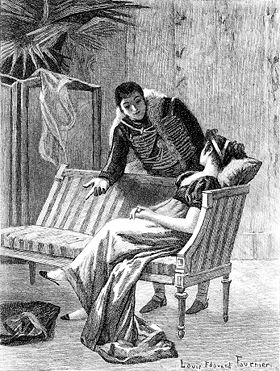Zixing said, “So in the Jia household, the first three [girls] are not bad. Old Mr Zheng’s oldest daughter, whose name is ‘Beginning-of-Spring,’ because everyone praised her virtue and talents, was chosen to enter the imperial palace as a lady-in-waiting. The second daughter is the daughter of old Mr She by his wife, and her name is ‘Welcome-the-Spring.” The third young lady is the daughter of Mr Zheng by a concubine, and her name is ‘Seek-for-Spring.’ The fourth young lady is on the Ning Mansion side [i.e. not in the same branch of the family] and is the younger sister of Mr. Zhen. Her name is ‘Regretting-the-Spring’….
Yucun said, “It was so intelligent that in the Zhen family’, the girls’ names always used to be the same kind as the boys’, not the way other families named girls– with those ‘glamorous’ names like ‘Spring’ or ‘Red’ or ‘Fragrant’ or ‘Jade.’ Why would the Jia family choose this kind of vulgar naming?”

Zixing said, “It doesn’t. But because the oldest young lady was actually born on the first day of the year, she was called ‘Beginning-of-Spring,’ so the others were named following that, with the name ‘Spring.’ But the generation before that, the girls were named like their brothers. Now to prove it, take your employer’s wife Mrs Lin, who was from the Rong family, the full sister of Jia She [shè means Clemency] and Jia Zheng [zhèng means Rule]. Her name was was Jia Min [min means Clever]. If you don’t believe me, you can ask for yourself.”
Yucun hit the table and said laughing, “No wonder my girl student, whenever she reads the word ‘Min,’ always reads it as ‘Mi’ and always leaves off one or two strokes of the brush [there was a taboo on writing the full names of one’s parents and the emperor]. It puzzled me. Now I hear you say that, there’s no more mystery! ”
—Cao Xueqin‘s Dream of the Red Chamber (Hong Lou Meng 紅樓夢 ) was written in the middle 1700s
子興道:「便是賈府中,現有的三個也不錯。政老爹的長女,名元春,現因賢孝才德,選入宮作女史去了。二小姐乃赦老爹之妾所出,名迎春;三小姐乃政老爹之庶出,名探春。四小姐乃寧府珍爺之胞妹,名喚惜春。。。」
雨村道:「更妙在甄家的風俗,女兒之名,亦皆從男子之名命字,不似別家另外用這些『春』『紅』『香』『玉』等艷字的。何得賈府亦樂此俗套﹖」
子興道:「不然。只因現今大小姐是正月初一日所生,故名元春,餘者方從了『春』字。上一輩的,卻也是從兄弟而來的。現有對証:目今你貴東家林公之夫人,即榮府中赦、政二公之胞妹,在家時名喚賈敏。不信時,你回去細訪可知。」
雨村拍案笑道:「怪道這女學生讀至書,凡中有『敏』字,她皆念作『密』字,每每如是;寫字遇著『敏』字,又減一二筆,我心中就有些疑惑。今聽你說的,是為此無疑矣!」



